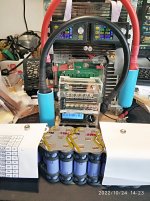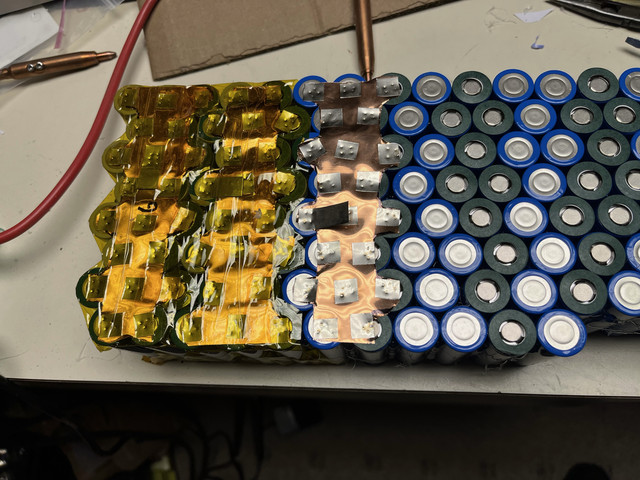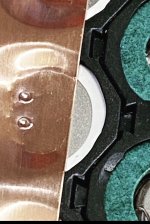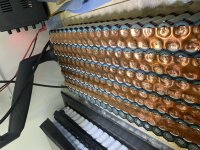You are using an out of date browser. It may not display this or other websites correctly.
You should upgrade or use an alternative browser.
You should upgrade or use an alternative browser.
"Copper/nickel sandwich" buses for series connections
- Thread starter spinningmagnets
- Start date
Hummina Shadeeba
1 MW
caleb7 said:I scanned the thread, I'm sure I'm missing something but how do you people come to conclusion that 1mm2 of copper sheet is capable of carrying, say as high as 30A? I'd like to use this design in future but not without knowing this. AWG ampacity charts say much lower ratings for solid wire, for example 1.3 mm2 copper wire is 15 Amps according to this list:
https://www.engineeringtoolbox.com/wire-gauges-d_419.html
I see on at least in one design, one cell was only getting a lip of copper sheet where it has like 1 cm width.
Is copper sheet better conductor than solid wire or its more capable because it's basically a sheet in 'air'?
I think these ratings are for household continuous use and very conservative even though for solid wire not stranded. There’s better ampacity testing and charts here on the site somewhere. Two.
As u say the thin sheet can dissipate heat in air better
maarkmohamed
100 W
- Joined
- Jan 10, 2019
- Messages
- 114
I've been following this thread and it's been very beneficial. I personally would like to attempt the copper sandwich but have a question. It seems like the nickel plated steel works best for getting good welds, that being said I would go for .15 thick copper. Firstly how much amps is .15 copper good for? I'm looking for something that can do 30a efficiently, and secondly does it matter whether I use nickel plated steel or pure nickel over the copper, because as mentioned in the previous posts, electricity usually takes the least resistive path, which possibly means it will just flow throw the copper?
ichiban
100 W
For sandwich technique, Ni(Fe) + Cu + Cell cap, you'd use only Ni(Fe) "Nickel-plated steel.
After I had problem with my kweld probe shorting on one pad of the during-assembly-pack and blew a TVS diode. Replaced it, but still not welding from 50J upto 180J. Asked Frank, he suspected some problems with internal resistance of the switching MosFet ? So he was kind enought to send me a new pcb. Replaced it and did some mods on my kWeld - it works again. Now I can achieve 1700-1800A (140J) on actual 0.15mm Ni(Fe) + 0.2mm Cu for the remaining (about 80%) of the pack of 20S3P. The pack is finished with welding just today. I use 2 parallel 12V30A cheap PSUs with 2 CC-CV programmable regulators that I supply 14A each simultaneously (through power diodes). It works fine except that one regulator is crappy with oftenly flickering display. I had to remove the box and clean internal connectors with contact cleaner spray several times already.
Spot welding pure copper requires at least 2,000A to start melting, better 3,000A and higher. Current kWeld cannot do that directly - without any mods or technique like sandwiching. Frank is woking on a higher version of kWeld, up to 4,500A. Should be dued next year.
Problems with spot-welding Cu is that it has very low R (loss as heat, hi R= hi heat) and conducts current too well that it is not heated up enough to directly weld it. According to Frank, we will need to dump very high current in the shortest time possible (Q). While Ni has about 4X higher R and requires less amp to create adequate heat and weld successfully - but still high. Luckily for sandwiching method, there is Ni(Fe), which is steel (5-6X higher resistance than copper) with microns of Ni plated only on its surface. When spot-welded this Ni(Fe) become very hot (much higer R) - enough to also melt copper next it. Also with the help of slot (or slit) on Cu and/or Ni(Fe) separating both probes from each other that will force majority of current to go even deeper through cell cap instead of just bypassing through Cu (low R) or Ni.
There are details of other mods / tricks I made with my kWeld, i.e : big cables, probes, bus bars, V set, fuse and etc. Each contributes to the success of this welding Ni(Fe) + Cu on its own. I will share the details I mod sometimes later. It will be lengthy though. Busy with so many things going on now.
Cautions : we are dealing with very higher current here with kWeld. Accident can happen. Be very careful. I now cover the pack with insulation and open only the pads that I am welding to prevent short that can damage kWeld permanently. That one single short cuase me a lot of headache and 6 weeks to get it back on track again.
I am grateful to Frank (Tatus1969) for his help and time and truely believe that he really stands by his product and reputation. Thank you, Frank. Actually, this post is to contribute to what I have learnt a lot form ES and all the generous guys here.
Also with special thanks to the people who discover sandwich-welding method and share it here. This technique enables us to use considerable lower current (with much less expensive welding machines) to successfully weld Cu.



** for some reasons, I cannot attach MP4 VDO clip for now. Otherwise, I can show my display and some of you guys can see what's with my system. Would anyone tell me how to do it, pls.
After I had problem with my kweld probe shorting on one pad of the during-assembly-pack and blew a TVS diode. Replaced it, but still not welding from 50J upto 180J. Asked Frank, he suspected some problems with internal resistance of the switching MosFet ? So he was kind enought to send me a new pcb. Replaced it and did some mods on my kWeld - it works again. Now I can achieve 1700-1800A (140J) on actual 0.15mm Ni(Fe) + 0.2mm Cu for the remaining (about 80%) of the pack of 20S3P. The pack is finished with welding just today. I use 2 parallel 12V30A cheap PSUs with 2 CC-CV programmable regulators that I supply 14A each simultaneously (through power diodes). It works fine except that one regulator is crappy with oftenly flickering display. I had to remove the box and clean internal connectors with contact cleaner spray several times already.
Spot welding pure copper requires at least 2,000A to start melting, better 3,000A and higher. Current kWeld cannot do that directly - without any mods or technique like sandwiching. Frank is woking on a higher version of kWeld, up to 4,500A. Should be dued next year.
Problems with spot-welding Cu is that it has very low R (loss as heat, hi R= hi heat) and conducts current too well that it is not heated up enough to directly weld it. According to Frank, we will need to dump very high current in the shortest time possible (Q). While Ni has about 4X higher R and requires less amp to create adequate heat and weld successfully - but still high. Luckily for sandwiching method, there is Ni(Fe), which is steel (5-6X higher resistance than copper) with microns of Ni plated only on its surface. When spot-welded this Ni(Fe) become very hot (much higer R) - enough to also melt copper next it. Also with the help of slot (or slit) on Cu and/or Ni(Fe) separating both probes from each other that will force majority of current to go even deeper through cell cap instead of just bypassing through Cu (low R) or Ni.
There are details of other mods / tricks I made with my kWeld, i.e : big cables, probes, bus bars, V set, fuse and etc. Each contributes to the success of this welding Ni(Fe) + Cu on its own. I will share the details I mod sometimes later. It will be lengthy though. Busy with so many things going on now.
Cautions : we are dealing with very higher current here with kWeld. Accident can happen. Be very careful. I now cover the pack with insulation and open only the pads that I am welding to prevent short that can damage kWeld permanently. That one single short cuase me a lot of headache and 6 weeks to get it back on track again.
I am grateful to Frank (Tatus1969) for his help and time and truely believe that he really stands by his product and reputation. Thank you, Frank. Actually, this post is to contribute to what I have learnt a lot form ES and all the generous guys here.
Also with special thanks to the people who discover sandwich-welding method and share it here. This technique enables us to use considerable lower current (with much less expensive welding machines) to successfully weld Cu.



** for some reasons, I cannot attach MP4 VDO clip for now. Otherwise, I can show my display and some of you guys can see what's with my system. Would anyone tell me how to do it, pls.
ichiban
100 W
for Matador's Ampacity chart :
https://www.endless-sphere.com/forums/viewtopic.php?f=3&t=109637&p=1605438&hilit=ampacity+matador#p1605438
Cannot find his original one. Only found my own link, above.
https://www.endless-sphere.com/forums/viewtopic.php?f=3&t=109637&p=1605438&hilit=ampacity+matador#p1605438
Cannot find his original one. Only found my own link, above.
maarkmohamed
100 W
- Joined
- Jan 10, 2019
- Messages
- 114
v85 said:This one: https://endless-sphere.com/forums/viewtopic.php?f=2&t=98849#p1447486
So according to that chart .15 copper at over 20mm wide is probably ideal for 30 amps correct?
ichiban
100 W
This Matador's chart is rather conservative.
From this chart Cu with 10mm width, 0.15mm thick should handle 21.33A continuously and safely. Your 20-mm width should be Ok to take 21.33*2 = 42.66A safely. This Cu size should be very OK for your 30A load with plenty of safety margin.
From this chart Cu with 10mm width, 0.15mm thick should handle 21.33A continuously and safely. Your 20-mm width should be Ok to take 21.33*2 = 42.66A safely. This Cu size should be very OK for your 30A load with plenty of safety margin.
maarkmohamed
100 W
- Joined
- Jan 10, 2019
- Messages
- 114
ichiban said:This Matador's chart is rather conservative.
From this chart Cu with 10mm width, 0.15mm thick should handle 21.33A continuously and safely. Your 20-mm width should be Ok to take 21.33*2 = 42.66A safely. This Cu size should be very OK for your 30A load with plenty of safety margin.
Good to know thank you
garolittle
10 kW
if you’re located in the southeast USA, Vextrek Inc. can spot weld .25 mm pure copper onto lithium ion packs
https://blog.sunstonewelders.com/vextrek-is-reshaping-go-kart-dreams-with-a-better-battery?utm_term=&utm_campaign=Sales-Performance%2BMax-PJW%2BCampaign%2B2&utm_source=adwords&utm_medium=ppc&hsa_acc=1786972239&hsa_cam=18586803562&hsa_grp=&hsa_ad=&hsa_src=x&hsa_tgt=&hsa_kw=&hsa_mt=&hsa_net=adwords&hsa_ver=3&gclid=Cj0KCQjwnvOaBhDTARIsAJf8eVOUkhuRlA0poFdQQhzw00H8Pa6ZYDrkXUKKEcpiAMFoctpfFMi6eKQaAqiSEALw_wcB
https://blog.sunstonewelders.com/vextrek-is-reshaping-go-kart-dreams-with-a-better-battery?utm_term=&utm_campaign=Sales-Performance%2BMax-PJW%2BCampaign%2B2&utm_source=adwords&utm_medium=ppc&hsa_acc=1786972239&hsa_cam=18586803562&hsa_grp=&hsa_ad=&hsa_src=x&hsa_tgt=&hsa_kw=&hsa_mt=&hsa_net=adwords&hsa_ver=3&gclid=Cj0KCQjwnvOaBhDTARIsAJf8eVOUkhuRlA0poFdQQhzw00H8Pa6ZYDrkXUKKEcpiAMFoctpfFMi6eKQaAqiSEALw_wcB
garolittle
10 kW
maarkmohamed
100 W
- Joined
- Jan 10, 2019
- Messages
- 114
I contacted them and they said they are not taking any work...garolittle said:if you’re located in the southeast USA, Vextrek Inc. can spot weld .25 mm pure copper onto lithium ion packs
https://blog.sunstonewelders.com/vextrek-is-reshaping-go-kart-dreams-with-a-better-battery?utm_term=&utm_campaign=Sales-Performance%2BMax-PJW%2BCampaign%2B2&utm_source=adwords&utm_medium=ppc&hsa_acc=1786972239&hsa_cam=18586803562&hsa_grp=&hsa_ad=&hsa_src=x&hsa_tgt=&hsa_kw=&hsa_mt=&hsa_net=adwords&hsa_ver=3&gclid=Cj0KCQjwnvOaBhDTARIsAJf8eVOUkhuRlA0poFdQQhzw00H8Pa6ZYDrkXUKKEcpiAMFoctpfFMi6eKQaAqiSEALw_wcB
garolittle
10 kW
maarkmohamed said:I contacted them and they said they are not taking any work...garolittle said:if you’re located in the southeast USA, Vextrek Inc. can spot weld .25 mm pure copper onto lithium ion packs
https://blog.sunstonewelders.com/vextrek-is-reshaping-go-kart-dreams-with-a-better-battery?utm_term=&utm_campaign=Sales-Performance%2BMax-PJW%2BCampaign%2B2&utm_source=adwords&utm_medium=ppc&hsa_acc=1786972239&hsa_cam=18586803562&hsa_grp=&hsa_ad=&hsa_src=x&hsa_tgt=&hsa_kw=&hsa_mt=&hsa_net=adwords&hsa_ver=3&gclid=Cj0KCQjwnvOaBhDTARIsAJf8eVOUkhuRlA0poFdQQhzw00H8Pa6ZYDrkXUKKEcpiAMFoctpfFMi6eKQaAqiSEALw_wcB
Hello Sir. My sincerest apologies for any misunderstanding. I own Vextrek and I just sent you a private message. Please feel free to contact me directly and we can assemble a battery pack for you. Would love to have you as a customer. Gary Little, Vextrek, Inc.
I had to use a little over 100 Joules when welding 0.15MM copper with 0.10MM x 8MM nickel plate steel caps. Using Kweld with 850CCA car battery. I had to with the positive side of the battery twice to get a good weld that would actually rip the copper when pulling off. Does that all sound normal?
xrracer72 said:I had to use a little over 100 Joules when welding 0.15MM copper with 0.10MM x 8MM nickel plate steel caps. Using Kweld with 850CCA car battery. I had to with the positive side of the battery twice to get a good weld that would actually rip the copper when pulling off. Does that all sound normal?
If that works fine for you then its fine I guess. If you want to get same result for less joules then you need to get amps up and time down so copper dont have time to soak up all the heat..
ossivirt said:xrracer72 said:I had to use a little over 100 Joules when welding 0.15MM copper with 0.10MM x 8MM nickel plate steel caps. Using Kweld with 850CCA car battery. I had to with the positive side of the battery twice to get a good weld that would actually rip the copper when pulling off. Does that all sound normal?
If that works fine for you then its fine I guess. If you want to get same result for less joules then you need to get amps up and time down so copper dont have time to soak up all the heat..
Makes sense. I am thinking about making some heavier gauge leads for the electrodes. I am assuming that would help. Thanks for the reply.
xrracer72 said:ossivirt said:xrracer72 said:I had to use a little over 100 Joules when welding 0.15MM copper with 0.10MM x 8MM nickel plate steel caps. Using Kweld with 850CCA car battery. I had to with the positive side of the battery twice to get a good weld that would actually rip the copper when pulling off. Does that all sound normal?
If that works fine for you then its fine I guess. If you want to get same result for less joules then you need to get amps up and time down so copper dont have time to soak up all the heat..
Makes sense. I am thinking about making some heavier gauge leads for the electrodes. I am assuming that would help. Thanks for the reply.
You can make heavier leads but dont make them any longer than original. That makes inductive kickback stronger and max amps that welder can survive lower. Best place to get more power is battery. You did not say how much current you currently have when welding but you can go up to 1800-2000A range with right battery and short leads. Go read K-Weld thread for all the info and users setups and results if you already have not and want to get best possible results!
ossivirt said:xrracer72 said:ossivirt said:xrracer72 said:I had to use a little over 100 Joules when welding 0.15MM copper with 0.10MM x 8MM nickel plate steel caps. Using Kweld with 850CCA car battery. I had to with the positive side of the battery twice to get a good weld that would actually rip the copper when pulling off. Does that all sound normal?
If that works fine for you then its fine I guess. If you want to get same result for less joules then you need to get amps up and time down so copper dont have time to soak up all the heat..
Makes sense. I am thinking about making some heavier gauge leads for the electrodes. I am assuming that would help. Thanks for the reply.
You can make heavier leads but dont make them any longer than original. That makes inductive kickback stronger and max amps that welder can survive lower. Best place to get more power is battery. You did not say how much current you currently have when welding but you can go up to 1800-2000A range with right battery and short leads. Go read K-Weld thread for all the info and users setups and results if you already have not and want to get best possible results!
I think I was around the 1700-1800 amp range but I haven't used it in awhile and cant remember. Next battery build I will probably parallel another car battery to what I have now.
Bbbbrass
1 W
Sorry to ask more in here, as there may be a more appropriate thread for this I didn't find.
Anyone use or have thoughts on these pre-made copper nickel strips?
https://www.amazon.com/gp/product/B0B789WW5D/ref=ppx_yo_dt_b_asin_title_o05_s00?ie=UTF8&psc=1
They claim 20A rating. I took a leap and ordered them and will let you all know what I see, however my testing methods are crude and undeveloped.
Anyone use or have thoughts on these pre-made copper nickel strips?
https://www.amazon.com/gp/product/B0B789WW5D/ref=ppx_yo_dt_b_asin_title_o05_s00?ie=UTF8&psc=1
They claim 20A rating. I took a leap and ordered them and will let you all know what I see, however my testing methods are crude and undeveloped.
Looks perfect for us. Kweld had done 0.15mm copper, and this has a nickel coating to avoid corrosion.
It would still need a steel cap, or nickel, or nickel-plated steel
It would still need a steel cap, or nickel, or nickel-plated steel
Hummina Shadeeba
1 MW
Bbbbrass said:Anyone use or have thoughts on these pre-made copper nickel strips?
https://www.amazon.com/gp/product/B0B789WW5D/ref=ppx_yo_dt_b_asin_title_o05_s00?ie=UTF8&psc=1
They claim 20A rating. I took a leap and ordered them and will let you all know what I see, however my testing methods are crude and undeveloped.
I have the same and couldn’t get them to weld with a nickel sandwich.
I think likely good for more than 20 amps.
Wish it was .1mm copper.
I have a Kweld, and couldn't get a good weld with .16mm copper + either a .1mm .2mm nickel strip on top. It would weld, but, pulled off too easily IMHO.
.1mm nickel on top of .08mm copper works great for me though. I use 80J to weld that sandwich. The .08mm copper has the same conductivity as .4mm nickel, which is great, plus I buy it 100mm wide foil. I just got done building a 14s10p pack with INR18650-33G cells. I used custom-cut copper sheets as combined series/parallel connections

.1mm nickel on top of .08mm copper works great for me though. I use 80J to weld that sandwich. The .08mm copper has the same conductivity as .4mm nickel, which is great, plus I buy it 100mm wide foil. I just got done building a 14s10p pack with INR18650-33G cells. I used custom-cut copper sheets as combined series/parallel connections

Thanks for posting that info...
Hummina Shadeeba
1 MW
Never seen this and was on the skate forum. Seem great. Wellgo Lifepo4 2s4p Parallel Nickel Strip 18650 21700 Battery Pack Spot Welding Tab Connector Flat Plate Copper Busbar - Buy Battery Pack Busbar Copper,Battery Busbar,Copper Busbar Lifepo4 Battery Product on Alibaba.com
I dont know anything about the manu or the product other than what the pics reveal
My attempts with nickel sandwiches didn’t go well. I did weld pure .1mm copper w the kweld but was very high power (I forget) and even then not the best welds
I dont know anything about the manu or the product other than what the pics reveal
My attempts with nickel sandwiches didn’t go well. I did weld pure .1mm copper w the kweld but was very high power (I forget) and even then not the best welds
Last edited:
Similar threads
- Replies
- 7
- Views
- 202
- Replies
- 12
- Views
- 817
- Replies
- 7
- Views
- 1,030




